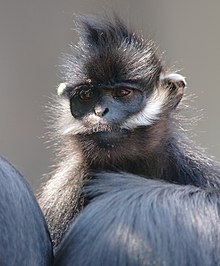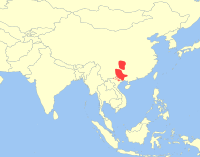François' langur
| François' langur | |
|---|---|
 |
|
| Scientific classification | |
| Kingdom: | Animalia |
| Phylum: | Chordata |
| Class: | Mammalia |
| Order: | Primates |
| Family: | Cercopithecidae |
| Genus: | Trachypithecus |
| Species group: | T. francoisi |
| Species: | T. francoisi |
| Binomial name | |
|
Trachypithecus francoisi (de Pousargues, 1898) |
|
 |
|
| Geographic range | |
The François' langur (Trachypithecus francoisi), also known as the Francois' leaf monkey, Tonkin leaf monkey, or white side-burned black langur is a species of lutung and the type species of its species group. It is the least studied of the species belonging to the Colobinae subfamily.
The species is distributed from Southwestern China to northeastern Vietnam. The total number of wild individuals is unknown, but fewer than 500 are believed to be left in Vietnam and 1,400–1,650 in China. About 60 langurs are in captivity in North American zoos. The species is named after Auguste François (1857–1935), who was the French Consul at Lungchow in southern China.
François' langur is a medium-sized primate with black, silky hair. It has very distinct white sideburns that grow down from its ears to the corners of its cheeks. A morphological specialization of François' langur is its complex stomach, made up of four separate chambers. This is a necessary adaptation for the digestion of its folivorous diet.
This species shows sexual dimorphism in its size. Males have a head-body length of 55–64 cm (22–25 in), while females are only 47–59 cm (19–23 in) in length. Males likewise have longer tails of 82–96 cm (32–38 in) compared to the 74–89 cm (29–35 in) for females. Males are significantly heavier than females, weighing 6.5–7.2 kg (14–16 lb) compared to 5.5–5.9 kg (12–13 lb) for females. Infants weigh 0.45–0.50 kg (16–18 oz) at birth.
François' langur has large salivary glands to begin the digestion of tough leaf fibers. A more notable evolutionary adaptation seen in this langur is the sacculated stomach with two chambers. In the upper chamber, bacteria help to continue the breakdown of fibers started by the saliva. The upper chamber has a relatively normal pH, to create favorable conditions for bacterial growth. The lower chamber is similar to that of other mammals, in that it contains the acids that finish the breakdown of food components.
François' langur is diurnal and spends most of the day resting and foraging. One study investigated time distribution across activities in a disturbed environment, showing resting 35.41%, foraging 31.67%, traveling 14.44%, huddling 9.61%, playing 8.54%, and grooming 0.33%. Traveling, playing, grooming and huddling are more dependent on the season. Interestingly, grooming has been found to occur in all seasons but spring. François' langur spends a greater part of its day travelling during the winter (20.12%) and huddling in the spring (14.62%).
...
Wikipedia

